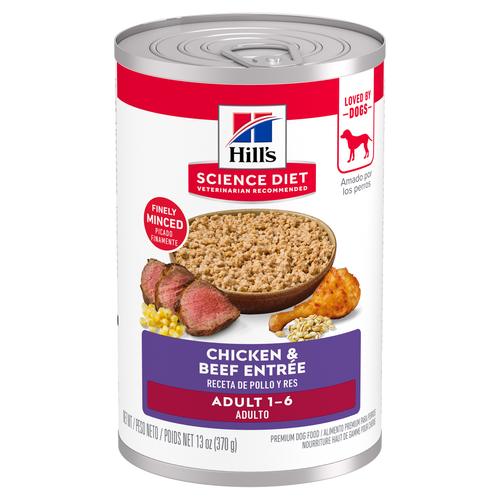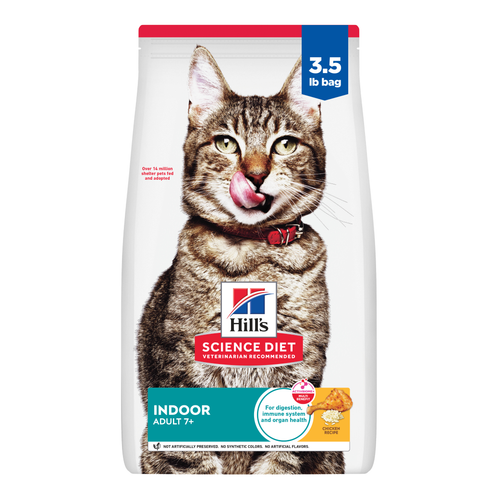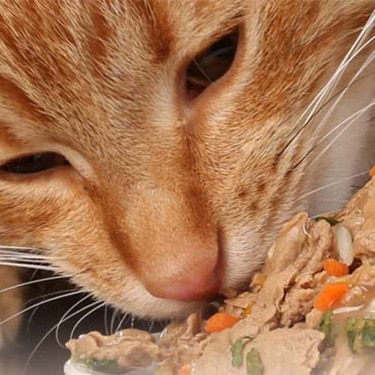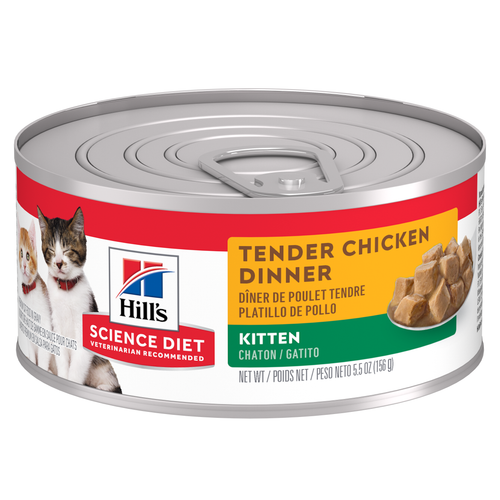
-
Find the right food for your petTake this quiz to see which food may be the best for your furry friend.Find the right food for your petTake this quiz to see which food may be the best for your furry friend.Featured products
 Adult Large Breed Chicken & Barley Recipe Dog Food
Adult Large Breed Chicken & Barley Recipe Dog FoodSupports healthy joints, lean muscle, and beautiful coat for large breed dogs
Shop Now Adult Chicken & Barley Recipe Dog Food
Adult Chicken & Barley Recipe Dog FoodSupports lean muscle and beautiful coat for adult dogs
Shop Now Hill's Science Diet Adult Chicken & Beef Entrée Dog Food
Hill's Science Diet Adult Chicken & Beef Entrée Dog FoodChicken & Beef Entrée in a delicious loaf with complete & balanced nutrition to help keep adult dogs active and healthy
Shop NowFeatured products Adult Turkey & Liver Entrée Cat Food
Adult Turkey & Liver Entrée Cat FoodPrecisely balanced nutrition with the delicious taste of minced turkey & liver to help fuel the energy needs of cats during the prime of their life
Shop Now Adult 7+ Indoor Chicken Recipe Cat Food
Adult 7+ Indoor Chicken Recipe Cat FoodSupports energy level and beautiful fur in mature indoor cats
Shop Now Senior Vitality Adult 7+ Tuna & Vegetables Stew
Senior Vitality Adult 7+ Tuna & Vegetables StewImproves Everyday Ability to Get Up & Go
Shop Now -
Dog
- Dog Tips & Articles
-
Health Category
- Weight
- Food & Environmental Sensitivities
- Urinary
- Digestive
- Joint
- Kidney
-
Life Stage
- Puppy Nutrition
- Adult Nutrition
- Senior Nutrition
Cat- Cat Tips & Articles
-
Health Category
- Weight
- Skin & Food Sensitivities
- Urinary
- Digestive
- Kidney
-
Life Stage
- Kitten Nutrition
- Adult Nutrition
Featured articles The Science Behind Our Love for Pets
The Science Behind Our Love for PetsLearn the scientific reasons why we have such strong connections with our pets, and what science says about the love between humans and our furry friends.
Read More What Is Littermate Syndrome? Pet Adoption Guide
What Is Littermate Syndrome? Pet Adoption GuideLearn more about littermate syndrome in dogs and cats and how to successfully navigate adoption and early socialization processes.
Read More How to Properly Mix Wet & Dry Pet Foods
How to Properly Mix Wet & Dry Pet FoodsAn Orange cat eating from a bowl filled with mixed food
Read More -


Cat parents are well aware that although their feline companions thrive on a routine, they also can get bored pretty quickly, which can lead to all sorts of mischief. Food puzzles for cats may be the perfect solution! These puzzles engage your cat's brain and get them moving.
What Is a Cat Food Puzzle?
Puzzles for cat food are typically plastic containers in a variety of colors, shapes and sizes. They're designed to make a pet "work for their food," explained the Cummings Veterinary Medical Center at Tufts University. Food puzzles for cats offer an environmental enrichment activity, and can be created out of any material or object that can safely hold edible items.
Cats can be very choosy about which type of food puzzle they like (no surprise there), so if your fur baby doesn't take to one right away, try others until you find one that pleases your picky pal. The key is to choose one that enhances their senses and instincts.
Types of Cat Food Puzzles
Most commercially bought cat food puzzles are intended for dry cat food but you can try wet food in them, too. When choosing which cat food to use in your puzzle, consider what the cleanup process will entail.
There are puzzles that require cats to lift up clear plastic cups, open drawers with their paws, or fish kibble out of a maze. Others necessitate the use of their mouth to lift out food. Some cat food puzzles sit on a sturdy base, while others lay flat on the ground.
Food puzzles for cats don't have to cost a lot of money. There are many commercially available options but you can make your own cat food puzzle using common household items like:
- Cardboard tubes
- Empty plastic water bottles
- Cardboard egg cartons
- Plastic cups
- Plastic ice cube trays
Mobile food puzzles are especially fun because your cat can roll them around the floor, adding an extra element of chase to the game. But make sure they can actually get the food out. The idea of these puzzles isn't to frustrate your cat but, rather, to engage them in a task for which they'll be rewarded.
And as always, prioritize your cat's safety, ensuring there are no sharp edges, small pieces that can be swallowed or pointy parts on the puzzle that can harm your kitty.


Tasty Tips
Benefits of Cat Food Puzzles
Food puzzles are beneficial for a cat's instinctive behavior in the following ways:
Curing Boredom
While it's true that cats sleep a lot, they need stimulation during their awake hours, or they could wind up wreaking havoc on your home. Cats retain a strong instinct for stalking and hunting, and supplying  a cat with a food puzzle offers an outlet for that instinct, said Mikel Delgado, a cat behavior expert, in an interview for Scientific American.
a cat with a food puzzle offers an outlet for that instinct, said Mikel Delgado, a cat behavior expert, in an interview for Scientific American.
Foraging for their food provides a truly enriching experience for domesticated cats. "Of course, it is not quite the same as hunting, but when combined with other forms of enrichment, such as interactive play, puzzles can really provide cats with the exercise and challenges they need to be happier," said Delgado.
Regulating Food and Managing Weight
Similar to treat-dispensing cat toys, food puzzles can be used to supply your kitty with their entire meal portion. International Cat Care points out that because puzzle feeders encourage mental and physical stimulation, using them to distribute meals is a great option for cats who aren't otherwise active.
Reducing Nighttime Feedings
Sleeping through the night without waking up to feed the cat is the stuff of daydreams for some pet parents. With a food puzzle, that hope could become a reality, as it provides your kitty with full access to their nocturnal meals. Also, cat puzzles make it so a cat can't scarf their whole meal down in minutes.
Consider using either stationary puzzles at night or confining mobile cat food puzzles to spaces far away from your bedroom so your slumber won't be disturbed by the racket.
The perfect cat food puzzle for your furry friend will engage them in the complete process of stalking, hunting and capturing prey. They may take a little while to warm up to the new toy, but once they do, you're sure to have one happy hunter on your hands.


Christine O'Brien is a writer, mom, and long-time cat parent whose two Russian Blues rule the house. Her work also appears in Care.com, What to Expect, and Fit Pregnancy, where she writes about pets, pregnancy, and family life. Find and follow her on Instagram and Twitter @brovelliobrien.
Related products

Supports energy level and beautiful fur in mature indoor cats

Precisely balanced nutrition with the delicious taste of minced turkey & liver to help fuel the energy needs of cats during the prime of their life

Improves Everyday Ability to Get Up & Go

Delectable chunks with tender chicken smothered in a rich gravy
Related articles

Discover how to train your cat, starting with very basic first steps that both reward good behavior and discourage the bad.

Discover which cat toys games your feline friend might like, and how they are great sources of exercise. Explore our library of articles to learn more.

Learn how to litter train a kitten with this guide to potty training, including when to start litter training kittens and troubleshooting tips.

When you adopt a cat, you don't just gain a best friend; you also save her life. Here's why getting a cat from a local animal shelter makes so much sense.

Put your cat on a diet without them knowing
Our low calorie formula helps you control your cat's weight. It's packed with high-quality protein for building lean muscles, and made with purposeful ingredients for a flavorful, nutritious meal. Clinically proven antioxidants, Vitamin C+E, help promote a healthy immune system.
Put your cat on a diet without them knowing
Our low calorie formula helps you control your cat's weight. It's packed with high-quality protein for building lean muscles, and made with purposeful ingredients for a flavorful, nutritious meal. Clinically proven antioxidants, Vitamin C+E, help promote a healthy immune system.

